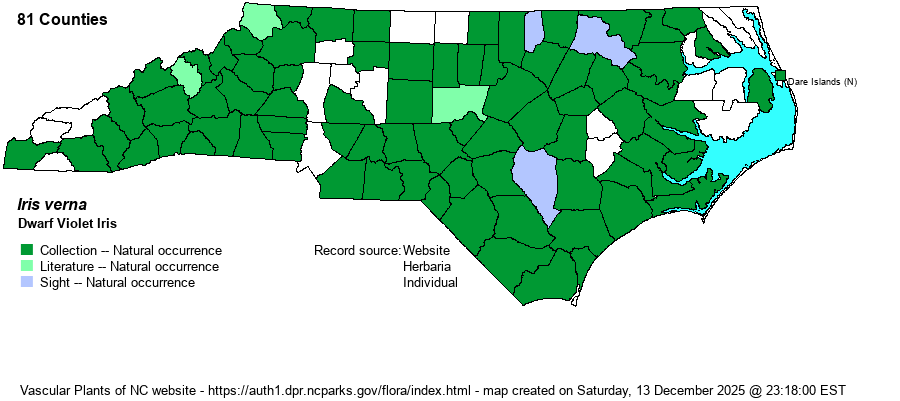| Author | L. | |
| Distribution | Found essentially statewide, but as with hundreds of other species, it is scarce to locally absent close to the northeastern coast. Note that there are two varieties in the state, neither being scarce -- var. smalliana being the one in the Mountains and western Piedmont, and the nominate var. verna occurring in the eastern 2/3rds of the state. There may be a narrow gap in the range between these two, in the central Piedmont.
The species is mainly a mid-Atlantic one, ranging north to southern PA and southern OH and south to northwestern FL and MS. It is disjunct to AR. | |
| Abundance | Generally fairly common over most of the Coastal Plain and eastern Piedmont; somewhat less numerous farther west, but still at least infrequent to fairly common in parts of the Mountains. Seems to be less numerous in the central Piedmont, and in the far eastern counties. Most widespread in the Sandhills region. As the species has been recorded from over 3/4th of the counties of the state, it should be considered with an S5 State Rank (as ranked on this website), as opposed to the S4 ranked by the NC NHP. | |
| Habitat | This is the only iris species in the state that favors dry habitats. It can be found in Longleaf Pine sandhills, dry to rocky upland woods, and dry roadbanks, bluffs, and outcrop margins. Var. verna also occurs in moist soil on slopes and in upper margins of streamhead ecotones; it responds well to recurring fires. | |
| Phenology | Blooms from March to May, and fruits from May to early August. As expected, the eastern variety flowers earlier than does the montane form. In the Sandhills it is remarkable to see this delicate flower rising up among the blackened soil shortly after a fire. | |
| Identification | This is one of the two native dwarf irises in the state. There are several basal leaves that are narrowly lanceolate and usually glaucous green, up to 8 inches long or more. They are arranged such that one leaf edge is pointed toward the flowering stem. The stem is only about 4-6 inches tall, topped by normally just a single very large flower, about 3 inches across. The petals and sepals are a violet color, a bit more deeply colored than on the similar I. cristata. The main distinguishing feature between the two is that this species has a large golden-yellow band on the sepals that is not "crested" or densely hairy (as in I. cristata). Of course, the habitats of the two are different, though they both could perhaps be seen within 100 yards of each other somewhere; the latter species favors rich forested slopes, though I. verna could grow on the drier soil at the top of a slope or bluff. Unlike with this latter species, I. verna does not grow in dense colonies; rather, it typically grows singly or just a handful of plants at a site. Thankfully, a person who spends much time in the Sandhills or the foothills and mountains can often find it in dry or rocky places. | |
| Taxonomic Comments | As mentioned above, two varieties exist in the state -- var. verna and var. smalliana. See the range maps for each of them on this website.
| |
| Other Common Name(s) | Dwarf Iris is the most frequent common name. However, I. cristata is a dwarf iris and is usually called Dwarf Crested Iris or Crested Dwarf Iris. Thus, "Dwarf Iris" becomes a nested name and is not suitable for a common name for I. verna. Several sites use Dwarf Violet Iris, which the website uses. | |
| State Rank | S4 [S5] | |
| Global Rank | G5 | |
| State Status | | |
| US Status | | |
| USACE-agcp | | |
| USACE-emp | | |

